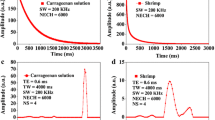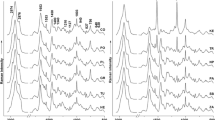Abstract
Magnetic resonance imaging (MRI) is a potent tool utilised in several areas of science. The present study contains a short outline of the function of this technique which was provided. Such applications cover the use of MRI in aquatic biology, in fish physiology, in the imaging of the zoological specimens deposited in the museums and in food processing. In the second part of the chapter, a review of the possible aspects where the MRI technique is possible to be used in Iraq was given. Judging from the recent political settlements in Iraq, it seems that the natural history specimens deposited in the Baghdad and Basrah natural history museums are the first issues to be taken into thoughtfulness in operating an MRI technique to save whatever’s left of the specimens after the destruction that occurred in Iraq in the last 15 years. It is also the aim of archiving in a digital library the current fauna of Iraq for the next generations. The other avenues where MRI can be applied in Iraq are the physiological studies on the anadromous fish species such as the clupeid fish Tenualosa ilisha and the future food processing industries.
Access this chapter
Tax calculation will be finalised at checkout
Purchases are for personal use only
Similar content being viewed by others
References
Belton PS, Gil AM, Webb GA, Rutledge D (2003) Magnetic resonance in food science: latest developments. RSC Publishing, Cambridge
Belton PS, Engelsen SB, Jakobsen HJ, Amin MHG, van den Berg F (2005) Magnetic resonance in food science: the multivariate challenge. RSC Publishing, Cambridge
Berquist RM, Gledhill KM, Peterson MW, Doan AH, Baxter GT, Yopak KE, Kang N, Walker HJ, Hastings PA, Frank LR (2012) The digital fish library: using MRI to digitize, database, and document the morphological diversity of fish. PLoS One 7(4):e34499
Blackband SJ (1989) NMR imaging: an appraisal of the present and the future. In: Anderson JH (ed) Innovations in diagnostic radiology research. Springer, Heidelberg, pp 69–92
Blackband SJ, Stoskopf MK (1990) In vivo nuclear magnetic resonance imaging and spectroscopy of aquatic organisms. Magn Reson Imaging 8(2):191–198
Bock C, Sartoris FJ, Pörtner HO (2002) In vivo MR spectroscopy and MR imaging on non-anaesthetized marine fish: techniques and first results. Magn Reson Imaging 20:165–172
Boistel R, Swoger J, Krzic U, Fernandez V, Gillet B, Reynaud EG (2011) The future of three-dimensional microscopic imaging in marine biology. Mar Ecol 32:438–452. https://doi.org/10.1111/j.1439-0485.2011.00442.x
Conner WE, Johnson GA, Coffer GP, Dittrich K (1988) Magnetic resonance microscopy—in vivo sectioning of a developing insect. Experientia 44:11–12
Davenel A, Gonzalez R, Suquet M, Quellec S, Robert R (2010) Individual monitoring of gonad development in the European flat oyster Ostrea edulis by in vivo magnetic resonance imaging. Aquaculture 307:165–169
Erikson U, Standal IB, Aursand IG, Veliyulin E, Aursand M (2012) Use of NMR in fish processing optimization: a review of recent progress. Magn Reson Chem 50(7):471–480
Farhat IA, Belton PS, Webb GA (2007) Magnetic resonance in food science: from molecules to man. RSC Publishing, Cambridge
Gassner G, Lohmann JAB (1987) Combined proton NMR imaging and spectral analysis of locust embryonic development. Proc Natl Acad Sci U S A 84:5297–5300
Giribet G (2010) A new dimension in combining data? The use of morphology and phylogenomic data in metazoan systematics. Acta Zool 91:11–19. https://doi.org/10.1111/j.1463-6395.2009.00420.x
Gujonsdottir M, Belton PS, Webb GA (2009) Magnetic resonance in food science: challenges in a challenging world. RSC Publishing, Cambridge
Hart AG, Bowtell RW, Köckenberger W, Wenseleers T, Ratnieks FLW (2003) Magnetic resonance imaging in entomology: a critical review. J Insect Sci 3:5
Howell N, Shavila Y, Grootveld M, Williams S (1996) High-resolution NMR and magnetic resonance imaging (MRI) studies on fresh and frozen cod (Gadus morhua) and haddock (Melanogrammus aeglefinus). J Sci Food Agric 72:49–56
Kaneko G, Ushio H, Ji H (2019) Application of magnetic resonance technologies in aquatic biology and seafood science. Fish Sci 85(1):1–17
Kiessling F, Pichler BJ, Hauff P (2011) Small animal imaging. Basics and practical guide. Springer, Berlin
Lohmann JAB, Gassner G (1987) Proton NMR in vivo imaging: a tool for studying embryo development of small organisms. Ann N Y Acad Sci 508:435–436
Marcone MF, Wang S, Albabish W, Nie S, Somnarain D, Hill A (2013) Diverse food-based applications of nuclear magnetic resonance (NMR) technology. Food Res Int 51:729–747
May EB, Bennet RO, Lipsky MM, Reimschuessel R (1987) Using fish as models in biomedical research. Lab Anim 16(4):23–28
Pouvreau S, Rambeau M, Cochard JC, Robert R (2006) Investigation of marine bivalve morphology by in vivo MR imaging: first anatomical results of a promising technique. Aquaculture 259:415–423
Renou JP, Belton PS, Webb GA (2011) Magnetic resonance in food science: an exciting future. RSC Publishing, Cambridge
Rowe T, Frank LR (2011) The disappearing third dimension. Science 331:712–714. https://doi.org/10.1126/science.1202828
Savorani F, Picone G, Badiani A, Fagioli P, Capozzi F, Engelsen SB (2010) Metabolic profiling and aquaculture differentiation of gilthead sea bream by 1H NMR metabonomics. Food Chem 120:907–914
Sawyer DB, Beyenbach KW (1987) Mechanism of fluid secretion in isolated shark renal proximal tubules. Am J Phys 249:F884–F890
Schröder L, Faber C (2011) In vivo NMR imaging. Methods and protocols., Methods in molecular biology, vol 771. Humana Press, New York
Stark DD, Bradley WG (1988) Magnetic resonance imaging, 1st edn. C.V. Mosby, St. Louis, MO
Suarez AV, Tsutsui ND (2004) The value of museum collections for research and society. Bioscience 54:66–74
Tokunaga T (1970) Trimethylamine oxide and its decomposition in the bloody muscle of fish. I. TMAO, TMA, and DMA contents in ordinary and bloody muscles. Nippon Suisan Gakkaishi 36:502–509. (In Japanese with English abstract)
Tyszka JM, Fraser SE, Jacobs RE (2005) Magnetic resonance microscopy: recent advances and applications. Curr Opin Biotechnol 16:93–99
Van der Linden A, Verhoye M, Pörtner HO, Bock C (2004) The strengths of in vivo magnetic resonance imaging (MRI) to study environmental adaptational physiology in fish. MAGMA 17(3-6):236–248
Walter T, Shattuck DW, Baldock R, Bastin ME, Carpenter AE, Duce S, Ellenberg J, Fraser A, Hamilton N, Pieper S, Ragan MA, Schneider JE, Tomancak P, Hériche JK (2010) Visualization of image data from cells to organisms. Nat Methods Suppl 7:S26–S41
Webb GA, Belton PS, Gil AM, Delgadillo I (2001) Magnetic resonance in food science: a view to the future. RSC Publishing, Cambridge
Ziegler A, Ogurreck M, Steinke T, Beckmann F, Prohaska S et al (2010) Opportunities and challenges for digital morphology. Biol Direct 5:45. https://doi.org/10.1186/1745-6150-5-45
Ziegler A, Kunth M, Mueller S, Bock C, Pohmann R et al (2011) Application of magnetic resonance imaging in zoology. Zoomorphology 130:227–254. https://doi.org/10.1007/s00435-011-0138-8
Author information
Authors and Affiliations
Editor information
Editors and Affiliations
Rights and permissions
Copyright information
© 2021 Springer Nature Switzerland AG
About this chapter
Cite this chapter
Jawad, L.A. (2021). It Is About Time to Use Magnetic Resonance in Fish Studies and Aquatic Ecological Risk Assessment in Iraq. In: Jawad, L.A. (eds) The Arabian Seas: Biodiversity, Environmental Challenges and Conservation Measures. Springer, Cham. https://doi.org/10.1007/978-3-030-51506-5_65
Download citation
DOI: https://doi.org/10.1007/978-3-030-51506-5_65
Published:
Publisher Name: Springer, Cham
Print ISBN: 978-3-030-51505-8
Online ISBN: 978-3-030-51506-5
eBook Packages: Biomedical and Life SciencesBiomedical and Life Sciences (R0)




